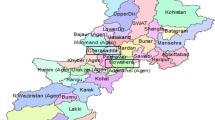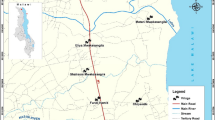Abstract
An environmental variation has caused Pakistan an alarming portrait of vulnerability in flood disasters. The government has focused on a number of realistic actions, heartening insertion of disaster risk-lessening measure by local disaster management policies instead of conventional dealings of aid-based approach due to the destructive outcome of floods and other natural disasters. In this study, household vulnerability and resilience of flood disaster in three districts of Punjab province were detailed. Data of a sample of the 840 inhabitant respondents of flood-prone areas of three districts of Punjab, which were severely affected in flooding of 2010, were collected from household respondent by face-to-face meeting and from Provincial Disaster Management Authority Punjab. A subjective method was used in the study to weight the components of vulnerability and resilience. In the empirical finding, higher vulnerability and lower resilience to the flood were found in these study areas. Muzaffargarh and Rajanpur districts were more vulnerable (higher composite vulnerable index score) and less resilient (lower composite resilience index score) in contrast to Rahim Yar Khan. The mutual contribution of local and provincial disaster management authorities can play the significant role in reducing vulnerability and increasing resilience of the inhabitants of flood-prone areas through strengthening awareness and vigilance, training regarding improving capacity of building and lessening flood costs.


Similar content being viewed by others
References
Abbas A, Amjath-Babu TS, Kächele H, Müller K (2015) Non-structural flood risk mitigation under developing country conditions: an analysis on the determinants of willingness to pay for flood insurance in rural Pakistan. Nat Hazards 75(3):2119–2135
Adger WN (2000) Social and ecological resilience: are they related? Prog Hum Geogr 24(3):347–364
Adger WN, Vincent K (2005) Uncertainty in adaptive capacity. C R Geosci 337(4):399–410
Adger WN, Brooks N, Bentham G, Agnew M, Eriksen S (2005) New indicators of vulnerability and adaptive capacity. Tyndall Centre for Climate Change Research, Norwich
Alexander DE (2000) Confronting catastrophe: new perspectives on natural disasters. Terra, Harpenden
Bahadur AV, Ibrahim M, Tanner T (2010) The resilience renaissance? Unpacking of resilience for tackling climate change and disasters.
Balica SF, Douben N, Wright NG (2009) Flood vulnerability indices at varying spatial scales. Water Sci Technol 60(10):2571–2580
Bohensky EL, Leitch AM (2014) Framing the flood: a media analysis of themes of resilience in the 2011 Brisbane flood. Reg Environ Change 14(2):475–488
Bosher L, Dainty A, Carrillo P, Glass J, Price A (2009) Attaining improved resilience to floods: a proactive multi-stakeholder approach. Disaster Prev Manag Int J 18(1):9–22
Bradford RA, O’Sullivan JJ, Van der Craats IM, Krywkow J, Rotko P, Aaltonen J, Bonaiuto M, De Dominicis S, Waylen K, Schelfaut K (2012) Risk perception—issues for flood management in Europe. Nat Hazards Earth Syst Sci 12(7):2299–2309
Braun B, Aßheuer T (2011) Floods in megacity environments: vulnerability and coping strategies of slum dwellers in Dhaka/Bangladesh. Nat Hazards 58(2):771–787
Burby RJ, Deyle RE, Godschalk DR, Olshansky RB (2000) Creating hazard resilient communities through land-use planning. Nat Hazards Rev 1(2):99–106
Center H (2002) Dam removal: science and decision making. Heinz Center for Science, Economics, and the Environment, Washington, DC
Cimellaro GP, Reinhorn AM, Bruneau M (2010) Framework for analytical quantification of disaster resilience. Eng Struct 32(11):3639–3649
Cutter SL, Boruff BJ, Shirley WL (2003) Social vulnerability to environmental hazards. Soc Sci Q 84(2):242–261
Cutter SL, Barnes L, Berry M, Burton C, Evans E, Tate E, Webb J (2008) A place-based model for understanding community resilience to natural disasters. Glob Environ Change 18(4):598–606
Cutter SL, Burton CG, Emrich CT (2010) Disaster resilience indicators for benchmarking baseline conditions. J Homel Secur Emerg Manag 7(1):1–22
Davidson MA (2006) Designing for disasters. Massachusetts Coastal Hazards Commission, NOAA Coastal Services Center, Silver Spring
Doocy S, Daniels A, Packer C, Dick A, Kirsch TD (2013) The human impact of earthquakes: a historical review of events 1980–2009 and systematic literature review. PLoS Currents 5:213
Dufty N (2008) A new approach to community flood education. Aust J Emerg Manag 23(2):4
Elena-Ana P, Costache A, Dan B, Dogaru D, Sima M (2013) Vulnerability assessment of rural communities to floods in the western part of Romania (Banat Plain). In: International multidisciplinary scientific geoconference: SGEM: surveying geology & mining ecology management, vol 1, p 1161
Esty DC, Levy M, Srebotnjak T, De Sherbinin A (2005) Environmental sustainability index: benchmarking national environmental stewardship. Yale Center for Environmental Law & Policy, New Haven, pp 47–60
Fuchs S, Thaler T (eds) (2018) Vulnerability and resilience to natural hazards. Cambridge University Press, Cambridge
Gallopín GC (2003) Box 1. A systemic synthesis of the relations between vulnerability, hazard, exposure, and impact, aimed at policy identification. In: Economic Commission for Latin American and the Caribbean (ECLAC) (ed) Handbook for estimating the socio-economic and environmental effects of disasters. ECLAC, LC/MEX/GS, Mexico, DF, pp 2–5
Gbetibouo GA, Ringler C (2009) Mapping South African farming sector vulnerability to climate change and variability: a subnational assessment. International Food Policy Research Institute (IFPRI) and Center for Environmental Economics and Policy in Africa (CEEPA), Washington, DC
Godschalk DR (2007) Mitigation. Emergency management: principles and practice for local government, pp 89–112
Gwimbi P (2007) The effectiveness of early warning systems for the reduction of flood disasters: some experiences from cyclone-induced floods in Zimbabwe. J Sustain Dev Afr 9(4):152–169
Hewitt K (2014) Regions of risk: a geographical introduction to disasters. Routledge, New York
Hirabayashi Y, Mahendran R, Koirala S, Konoshima L, Yamazaki D et al (2013) Global flood risk under climate change. Nat Clim Change 3:816
International Strategy for Disaster Reduction (2004) Living with risk: a global review of disaster reduction initiatives, vol 1. United Nations Publications, New York
IPCC (2007) Synthesis report. Cambridge University Press, Cambridge
IPCC (2017) Global warming of 1.5 °C summary for policy makers special report 2017, Intergovernmental Panel on Climate Change (IPCC). https://report.ipcc.ch/sr15/pdf/sr15_spm_final.pdf
Joerin J, Shaw R, Takeuchi Y, Krishnamurthy R (2012) Assessing community resilience to climate-related disasters in Chennai, India. Int J Disaster Risk Reduct 1:44–54
Karmaoui A, Balica SF, Messouli M (2016) Analysis of applicability of flood vulnerability index in pre-Saharan region, a pilot study to assess flood in Southern Morocco. LHEA (URAC 33), Department of Environmental Sciences, Faculty of Sciences Semlalia, Cadi Ayyad University, Marrakesh, Morocco
Khan AN (2013) Analysis of 2010-flood causes, nature and magnitude in the Khyber Pakhtunkhwa, Pakistan. Nat Hazards 66(2):887–904
Kissi AE, Abbey GA, Agboka K, Egbendewe A (2015) Quantitative assessment of vulnerability to flood hazards in downstream area of Mono Basin, South-Eastern Togo: Yoto District. J Geogr Inf Syst 7(06):607
Klein D, Luderer G, Kriegler E, Strefler J, Bauer N, Leimbach M, Popp A, Dietrich JP, Humpenöder F, Lotze-Campen H, Edenhofer O (2014) The value of bioenergy in low stabilization scenarios: an assessment using REMIND-MAgPIE. Climatic change 123(3–4):705–718
Krausmann E, Mushtaq F (2008) A qualitative Natech damage scale for the impact of floods on selected industrial facilities. Nat Hazards 46:179–197
Ludy J, Kondolf GM (2012) Flood risk perception in lands “protected” by 100-year levees. Nat Hazards 61(2):829–842
Maantay J, Maroko A (2009) Mapping urban risk: flood hazards, race, & environmental justice in New York. Appl Geogr 29(1):111–124
Miceli R, Sotgiu I, Settanni M (2008) Disaster preparedness and perception of flood risk: a study in an alpine valley in Italy. J Environ Psychol 28(2):164–173
Motsholapheko MR, Kgathi DL, Vanderpost C (2012) Rural livelihood diversification: a household adaptive strategy against flood variability in the Okavango Delta, Botswana. Agrekon 51(4):41–62
Nelson R, Kokic P, Crimp S, Martin P, Meinke H et al (2010) The vulnerability of Australian rural communities to climate variability and change: part II—integrating impacts with adaptive capacity. Environ Sci Policy 13:18–27
Norris FH, Stevens SP, Pfefferbaum B, Wyche KF, Pfefferbaum RL (2008) Community resilience as a metaphor, theory, set of capacities, and strategy for disaster readiness. Am J Community Psychol 41(1–2):127–150
Papathoma-Koehle M, Thaler T, Fuchs S (2016) Physical resilience of buildings to torrential hazards-relationship and interaction with physical vulnerability. In: EGU General Assembly conference abstracts, vol 18, p 11769
Pelling M (2003) The vulnerability of cities: social resilience and natural disaster. Earthscan, London, p 212
Piya L, Maharjan KL, Joshi NP (2012) Vulnerability of rural households to climate change and extremes: Analysis of Chepang households in the Mid-Hills of Nepal. In: 2012 conference, August, pp 18–24
Poussin JK, Botzen WW, Aerts JC (2014) Factors of influence on flood damage mitigation behaviour by households. Environ Sci Policy 40:69–77
Proag V (2014) The concept of vulnerability and resilience. Proc Econ Finance 18:369–376
Provencal Disaster Management Authority (2014) Punjab disaster response plan report
Qasim S, Khan AN, Shrestha RP, Qasim M (2015) Risk perception of the people in the flood-prone Khyber Pukhthunkhwa province of Pakistan. Int J Disaster Risk Reduct 14:373–378
Rose A (2004) Defining and measuring economic resilience to disasters. Disaster Prev Manag Int J 13(4):307–314
Rose A (2007) Economic resilience to natural and man-made disasters: multidisciplinary origins and contextual dimensions. Environ Hazards 7(4):383–398
Scheuer S, Haase D, Meyer V (2011) Exploring multicriteria flood vulnerability by integrating economic, social and ecological dimensions of flood risk and coping capacity: from a starting point view towards an end point view of vulnerability. Nat Hazards 58(2):731–751
Schinke R, Kaidel A, Golz S, Naumann T, López-Gutiérrez JS, Garvin S (2016) Analysing the effects of flood-resilience technologies in urban areas using a synthetic model approach. ISPRS Int J Geo Inf 5(11):202
Schmuck H (2000) “An Act of Allah”: religious explanations for floods in Bangladesh as survival strategy. Int J Mass Emerg Disasters 18(1):85–96
Shafique M, Khan MY (2015) Earthquake hazards and risk mitigation in Pakistan. In Disaster risk reduction approaches in Pakistan. Springer, Tokyo, pp 101–117
Shah AA, Ye J, Abid M, Ullah R (2017) Determinants of flood risk mitigation strategies at household level: a case of Khyber Pakhtunkhwa (KP) province, Pakistan. Nat Hazards 88(1):415–430
Shah AA, Ye J, Abid M, Khan J, Amir SM (2018) Flood hazards: household vulnerability and resilience in disaster-prone districts of Khyber Pakhtunkhwa province, Pakistan. Nat Hazards 93(1):147–165
Tariq MAUR (2013) Risk-based flood zoning employing expected annual damages: the Chenab River case study. Stoch Environ Res Risk Assess 27(8):1957–1966
Tierney K (2009) Disaster response: research findings and their implications for resilience measures, CARRI research report, vol 6. Oak Ridge, TN
Tierney KJ, Lindell MK, Perry RW (2002) Facing the unexpected: disaster preparedness and response in the United States. Disaster Prev Manag Int J 11(3):222–222
Vincent K (2004) Creating an index of social vulnerability to climate change for Africa. Tyndall Center for Climate Change Research. Working paper, vol 56, no 41
Vincent K (2007) Uncertainty in adaptive capacity and the importance of scale. Glob Environ Change 17(1):12–24
Wilkinson E, Brenes A (2014) Risk-informed decision-making: an agenda for improving risk assessments under HFA2. Produced for the climate and development knowledge network (CDKN) learning network on the use of climate and disaster risk assessments project, London
World Health Organization (2011) World Bank. World report on disability, 206
Yaqub M, Eren B, Doğan E (2015) Flood causes, consequences and protection measures in Pakistan. Disaster Sci Eng 1(1):8–16
Author information
Authors and Affiliations
Corresponding author
Additional information
Publisher's Note
Springer Nature remains neutral with regard to jurisdictional claims in published maps and institutional affiliations.
Rights and permissions
About this article
Cite this article
Ahmad, D., Afzal, M. Household vulnerability and resilience in flood hazards from disaster-prone areas of Punjab, Pakistan. Nat Hazards 99, 337–354 (2019). https://doi.org/10.1007/s11069-019-03743-9
Received:
Accepted:
Published:
Issue Date:
DOI: https://doi.org/10.1007/s11069-019-03743-9




